Viruses and Prisons - Microbiology (Midterm 1)
1/147
There's no tags or description
Looks like no tags are added yet.
Name | Mastery | Learn | Test | Matching | Spaced |
|---|
No study sessions yet.
148 Terms
Are viruses cellular or acellular?
Viruses are acellular
What are viruses made of?
A few organic moles (nucleic acids, proteins; some have lipids)
What life processes do viruses lack? (4)
metabolism
growth
responsiveness
reproduction
Can viruses reproduce on their own?
No, they are obligate intracellular parasites - they must invade host cells to reproduce
What is a modern example of a viral disease?
COVID-19
What is the proper definition of a virus?
A small, acellular, infectious agent with one or more pieces of nucleic acid (DNA or RNA)
What is the extracellular state of a virus called?
A virion
What does a virion consist of?
A protein coat (capsid), surrounding the nucleic acid core; some have an envelope
What’s the intracellular state of a virus infection called?
virus
How does the genome of a virus show more variety than other cellular organisms? (3)
Viral genomes can have DNA or RNA, which can be single of double stranded.
Viral genomes can be linear or circular
Viral genomes can be single or multiple copies
Viral genomes are much smaller
Compare the size of some viral genomes with the amount of genes in E. Coli?
Viral genomes are much smaller, sometimes only with 3 genes compared to 4000 genes in E.Coli
What determines the specificity of a virus for its host (virus matching to host (“lock and key”)
Viral surface or complementary proteins that match proteins on the host cell surface.
Give an example of a virus with narrow host specificity.
HIV, which can only access one or two types of host cells.
Give an example of a virus with broad host specificity.
West Nile virus, sometimes called a “master-key” virus because it infects many different hosts.
What is a bacteriophage?
A virus that specifically infects bacteria.
What determines the virions shape? (4)
Capsid proteins
The viral genome
envelopes
Assembly rules (chemical/structural rules)
What are virus capsids made out of?
Protein subunits called capsomeres.
What are the three main virion shapes?
Helical
Polyhedral
Complex
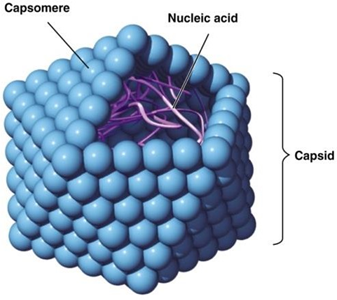
Using the image above name this virion shape and give a definition and example of a virion that has it.
Helical Virion Shape
Capsomeres joined in spiral fashion
Rabies Virus
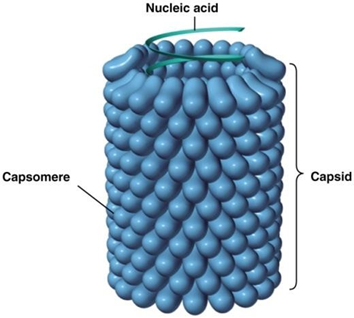
Using the image above name this virion shape and give a definition and example of a virion that has it.
Polyhedral
Spherical, many sided
Adenovirus
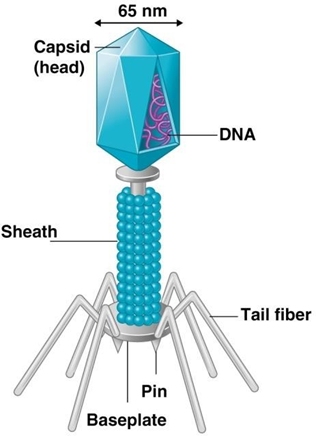
Using the image above name this virion shape and give a definition and example of a virion that has it.
Complex
Different shapes, not purely helical or purely polyhedral
Bacteriophage
What is a viral envelope, and where does it come from?
A membrane-like covering around the capsid, acquired from the host cells membrane.
What proteins fill the region between the capsid and envelope?
matrix proteins
What is two classifications of virion based on having or not having an envelope?
Enveloped virion
Non-enveloped
What role does the envelope play in viral infection?
It is involved in recognition and attachment to host cells
What are viral spikes, where do they come from?
Glycoproteins on the envelope of the virion, installed onto host cell membrane after being encoded from specific viruses genome (envelope)
What are the function of virion spikes?
Spikes act like “keys” for attachment to other host cells
What are the 4 main criteria for classifying viruses?
Type of nucleic acid
Presence of an envelope
Shape
Size
Virus family names end in what suffix? (example)
viridae (paramyxoviridae)
Virus genus names end in what suffix? (example)
virus (morbillivirus)
How are viral species named? (example)
With no suffix, just common name (measles virus)
How are viral subspecies designated? (example)
designated by a number (Influenza A H1N1 - “swine flu”)
Why do viruses depend on host cell machinery for replication?
Because they lack ribosomes, enzymes, and metabolic pathways.
What is the bacterial host cell forced to do in viral replication?
forced to replicate viral genome
__________ are the only type of virus to undergo lytic replication.
Bacteriophages
What usually happens to the bacterial host cell in the lytic cycle of viral replication?
The host cell bursts/dies (lyse)
During the lytic replication cycle how fast can bacteriophages replicate?
1 phage can become 1 trillion phages in 2 hours
What are the 5 stages of lytic replication?
Attachment
Entry
Synthesis
Assembly
Release
If bacteriophages are non-motile how do they encounter other host cells?
by random collision
What structure of the “phage” attaches to the bacteria host cell? (phage means bacteriophage)
Tail Fibers
What determines what bacteria host cell a phage can infect?
depends on chemical attraction and precise fit
____________ of bacteriophage and bacterial host cell ensures specificity.
Complementary (lock and key)
What enzyme does the phage carry that helps it enter and how?
Lysozyme - digests part of the bacterial cell wall and creates a small opening for the tail sheath
How does the phage inject its genome into a bacterial cell?
By contracting its tail sheath which forces a hollow tube through the cell wall and membrane; injecting genome through tube into bacterium
What happens to the phages capsid after injecting it’s genome into the bacterium?
left outside… like a spacecraft
What happens to the bacterium’s (normal) synthesis during the lytic cycle?
It stops making its own molecules and instead makes new viral components
Which machinery in the host cell bacterium is used to make viral proteins during synthesis of the lytic cycle?
Host ribosomes
What important viral products are made during (lytic) synthesis?
Viral components, viral DNA polymerase, and lysozyme
What do capsomeres form during assembly in the lytic cycle?
They accumulate, forming new capsids
How does the viral genome get into the capsid during assembly?
Enzymes pump the genome into the assembled capsid
What viral parts come together to form a mature virion during the assembly process?
Tails, tail fibers, capsid assemble
What role does lysozyme play during the release stage?
It continues digesting the bacterial cell wall
What happens after the bacterial cell wall is digested in the release stage?
Virions released, and the viral load can be measured in the host.
How long is one lytic cycle?
approximately 25 mins
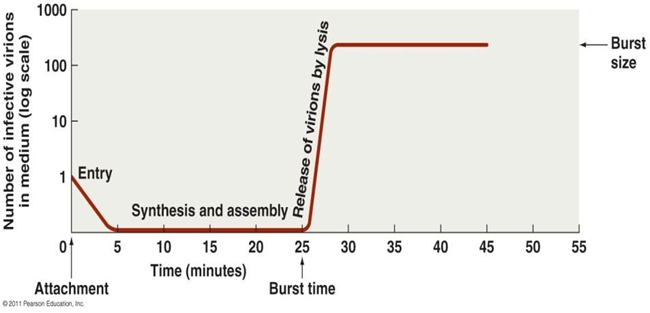
What is burst size?
number of virions released per cell.
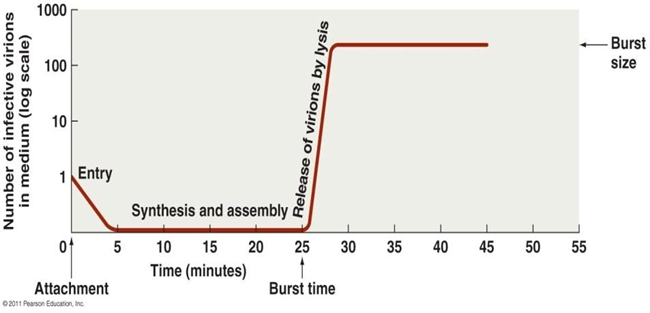
What is burst time?
Time to complete one cycle.
What is lysogeny?
Bacteriophage DNA integrates into host DNA
What is the incorporated DNA from the phage called?
Prophage
What is the lysogenic replication cycle?
Phage DNA integrates within the hosts bacterial chromosome, the infected cells grow and reproduce as normal.
What happens during the induction part of lysogenic replication cycle?
Occasionally the prophage may excise from host DNA, initiating a lytic cycle.
Some example of disease caused by lysogenic conversion? (3)
Diphtheria
Cholera
Diarrhea
What are the 5 stages of animal virus replication?
Attachment
Entry and Uncoating
Synthesis
Assembly
Release
what does attachment depend on and how do animal viruses attach to host cells?
Depends on the chemical interaction and exact fit. When correct they use glycoprotein spikes or other molecules on capsid/envelope
Animal viruses enter the host shortly after attachment, name three different ways they do so.
Direct penetration
Membrane fusion
Endocytosis
What happens in direct penetration during the entry of an animal virus?
The capsid sinks into plasma membrane, forms a pore, genome then enters.
Example of an animal virus that uses direct penetration for entry?
Poliovirus.
What happens in membrane fusion of an animal virus?
Viral envelope and host cell membrane fuse, full capsid are then released inside.
What is required in membrane fusion after the capsid enters the host and what remains of the envelope and where?
Uncoating of the capsid and viral glycoproteins remain in cytoplasmic membrane from fusion.
Examples of viruses using fusion?
Measles, HIV
How does endocytosis entry work for animal viruses?
The virus attaches to receptor on cell surface stimulating endocytosis of the host cell, the virus then gets engulfed.
What follows after the animal virus enters the host cell?
uncoating of the viruses capsid.
Example of a virus entering by endocytosis?
Herpesvirus.
What does synthesis for replication of animal viruses depend on?
The type of nucleic acid the animal virus has.
In synthesis of animal virus replication where does DNA typically like to enter and where does RNA typically like to replicate?
DNA viruses typically enter the nucleus
RNA viruses replicate in the cytoplasm
Assembly: where do DNA and RNA viruses like the assemble in the host cell?
DNA viruses assemble in nucleus
RNA viruses assemble in cytoplasm
Release: how do enveloped animal viruses release out the host cell?
by budding.
Release: What is budding?
release of enveloped viruses through cell membrane as they go through the virion acquires portion of membrane and some glycoproteins.
Does the budding process cause the host cell to die?
No, not immediately anyway
Release: how do non-enveloped animal viruses exit?
Exocytosis
What is exocytosis?
budding without an envelope, causes cell lysis and death of host.
Bacteriophage and Animal Phage: review, correct answer is “ok” but only after reading.
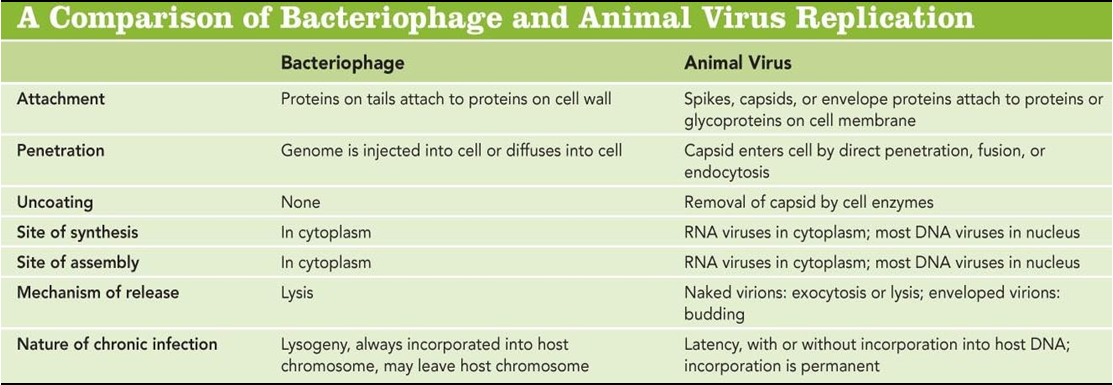
ok
What is a persistent infection?
viruses not completely eliminated and remains in the body producing virus particles or remaining latent over a long period
What are the two types of persistent infections by animal viruses
Latency
Chronic infection
What is latency?
Animal virus remaining dormant in host cells with no viral activity, signs, or symptoms for possibly years.
What happens when some animal viruses incorporate into the host chromosome?
They become a provirus - their DNA integrate into the host genome.
What’s the difference between a prophage and a provirus if they both integrate their DNA into host genome?
Unlike a prophage in bacteria, a provirus is permanent
What’s an example of a provirus?
HIV
What is a chronic infection?
Recurrent or prolonged symptoms
Under normal conditions, how is cell division controlled?
Cell division is tightly regulated by proto-oncogenes (promoters) and tumor suppressor genes (inhibitors)
What is neoplasia and what can happen as result?
Uncontrolled cell division that can produces a mass of cells called a tumor.
When’s the only time neoplasia doesn’t form a tumor? what does it cause instead?
In lymphoid and blood (liquid) tissues. It can still cause cancers like lymphoma and leukemia.
What’s the difference between benign and malignant tumors?
Benign remain in one place, malignant tumors invade neighboring tissues
What is metastasis?
the process by which malignant tumors spread through the body and invade other organs and tissues.
What happens when a proto-oncogene becomes an oncogene?
Uncontrolled cell division and can lead to tumor formation if not properly repressed
What happens during the first “hit” in virus-induced cancer development?
A virus inserts a promoter near the proto-oncogene, making it a oncogene.
What is the result of the first “hit” in virus induced cancer development?
As long as the repressor gene is intact, the repressor protein keeps oncogene at bay. Result: no cancer.
What happens when the second “hit” in virus induced cancer development?
Virus inserts into repressor gene, disrupting it. No repressor protein made, oncogene is no longer in check.
What is the result of the second “hit” in virus induced cancer development?
Oncogene activation. abnormal cell division. Result: Cancer
Why is cancer development often described as requiring “multiple hits”?
A single activation of oncogene is not enough; additional mutations are necessary to trigger cancer.
About what percentage of human cancers are caused by viruses?
Viruses cause 20-25% of human cancers